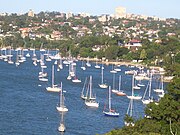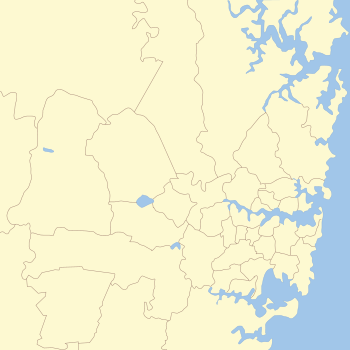South
West
South-West
Suburbs
Suburbs
Suburbs
North-West
Suburbs
North
District
Northern
Beaches
Northern
Beaches
The Northern Suburbs (also known as Central North, Inner Northwest, Macquarie District, Ryde District and Northern District) is a general term used to describe the metropolitan area on the northern bank of the Parramatta River in Sydney, New South Wales, Australia east of West Pennant Hills and west of the Lane Cove National Park, south of Hornsby. This area includes suburbs in the local government areas of Hornsby Shire, City of Ryde, City of Parramatta and Municipality of Hunters Hill. Because this is not a clearly defined region (although having a clearly differently defined lifestyle and social groups over the north shore region), the term 'Northern Suburbs' may also be applied to suburbs in the Upper North Shore, Lower North Shore, Hills District and even the Northern Beaches.
The Northern Suburbs of Sydney are characterised by pristine waterways with immense greenery, a good public transport system, large plots of land, and substantial bungalow style homes. [1] The region is home to an innumerable amount of parks and reserves, the region's largest being Pennant Hills Park. Major waterways in the region include the Parramatta River, Lane Cove River and the many creek systems that branch out from these aquatic lifelines.
Suburbs and localities of Northern Suburbs[]

Parramatta River at Hunters Hill

Macquarie University grounds
The suburbs and localities of the region generally known as Northern Suburbs are:
Suburbs[]
|
|
|
Localities[]
|
|
|

Curzon Hall, Marsfield
Culture and Sport[]
The Northern Suburbs is a culturally diverse region. Surrounding the Eastwood/Carlingford area a large number of asian immigrants have settled, largely due to the high academic achievements of the local schools at the time. Furthermore, this area has become an area of the upper middle class and a breeding ground for "New Money".
Sport is represented in many areas in the region, Ryde-Eastwood leagues club is the Club in the area, in regard to Rugby League and it covers the area of the famed Holy Cross College, Ryde. This league following can be attributed to the large Catholic population of the early developmental days of Rugby League in Australia, though the area now only retains two Junior rugby league clubs, both feeding to Holy Cross.
Eastwood District Rugby Union Football club represents the region in Rugby Union. It is considered one of the stronger clubs in the Shute Shield, consistently performing well. This club is considered a gateway club for Rugby Union into the Western Sydney area. Its consistent performance is due to the fact it has established a strong Juniors and Sub District competition within the area, many children from the area are sent to the elite private schools of Sydney and hold Rugby Union as the preferred code. Local school St Josephs, Hunters Hill is a traditional rugby school and the Kings School to the west help reinforce this strength.
History[]
Before European settlement, the Central North Region was home to the Wallumettagal (Ryde-Hunters Hill & Western Lane Cove) tribe. The first settlement in the Northern Suburbs and in fact the third-earliest in Australia, after Sydney and Parramatta, was at Ryde; then known by the Aboriginal name Wallumetta. Little is known about the original inhabitants of the Northern districts. All of the information that we have is from the accounts of Europeans in the first few years of the founding of the colony. The territory from Sydney Cove to Parramatta, on the northern side of the Parramatta River, was thought to be that of the Wallumedegal, and had the aboriginal name Wallumetta, the territory of the Wallumede people.
Aboriginal people in the Sydney district were clans of larger groups sharing a common language. Three language groups have been identified in the Sydney Region - the Kuringgai (or Guringai), the Dharug (or Dharruk / Dharuk / Darug), and the Dharawal(or Tharawal). The Wallumedegal are thought to have been within the Dharug speaking area.
On the 3rd January 1792, the first land in the Ryde area was granted to eight marines, along the northern bank of the river between Sydney and Parramatta. The area was named by Governor Phillip the 'Field of Mars', Mars being the ancient God of war, named to reflect the military association with these new settlers. Today's Field of Mars Reserve is the remnant of a district which once extended from Dundas to the Lane Cove River. These grants were followed soon after by grants to ten emancipated convicts in February 1792, the land being further to the east of the marines grants, thus the area was called Eastern Farms or the Eastern Boundary. By 1794 the name Eastern Farms had given way to Kissing Point, a name believed to have originated from the way in which heavily laden boats passing up the Parramatta River bumped or 'kissed' the rocky outcrop which extends into the river at today's Kissing Point.
Further grants were issued in 1794 and 1795, gradually occupying most of the foreshores between Meadowbank and Gladesville. Some of the grants were at the North Brush, north of the Field of Mars settlement, in the area of Brush Farm and Eastwood. Most of the Grants were small, from thirty to 100 acres (0.40 km2).
By 1803 most of the accessible land had been granted. Settlement was based along the Parramatta River and overlooking ridges. Governor King recognised that most of the smaller settlers had insufficient land for their stock but it was not possible to grant them larger allotments. In 1804 it was decided that a 'traditional English common' - a large area of public land for use by local inhabitants - would be set aside. Six commons were gazetted.
The Field of Mars Common, an area of approximately 5,050 acres (20.44 km2) located north of the Field of Mars and the Eastern Farms, covered most of the Ryde municipality. The village itself comprised only a modest scattering of houses in a few streets around the church, surrounded by farms, orchards and some large estates. Nevertheless the name was well-established by 12 November 1870 when the Municipal district of Ryde was officially proclaimed.
Transport[]
The Northern Suburbs are very well serviced by public transport. The Northern railway Line has frequent services to the city via Strathfield with the integration of the new Epping to Chatswood rail link into the Northern railway Line.
There are also an abundance of bus routes serving the region such as the 200 series bus routes and the 500 series bus routes, all operated by Sydney Buses. The Southern part of this region is frequented by ferry services to the CBD and westbound towards Parramatta.
Landmarks[]
The Northern Suburbs have many landmarks, including Macquarie University, The Ryde Civic Plaza, Brush Farm House in Eastwood, Gladesville Bridge, Ryde Bridge, Ryde Hospital, Macquarie Centre & Ice Skating Rink and Curzon Hall in Marsfield.
Landmark churches and cathedrals in the area include St Annes in Top Ryde (Australia's third oldest) and St Andrews in Eastwood.

Macquarie Centre's main entrance on Herring Road
Commercial Areas[]
The "Sydney Global Corridor", is used to describe a geographical 'arch' of Sydney, home to international corporations.Macquarie Park and North Ryde) are where many global companies have their Asia Pacific or Australian Headquarters.
The area is undisputedly Australia's hi-tech hub and is home to scores of international corporations including Microsoft, Boeing, Fujitsu, HP, Avaya and Optus. The area also has the Ryde-Hunters Hill Equestrian Club, a quality golf course, an Olympic field hockey venue, the Macquarie University and Macquarie Centre.
The view of Sydney from the Gladesville Bridge
Events and celebrations[]
The largest annual event in the Northern Suburbs is the Granny Smith Festival held in the suburb of Eastwood usually in October of each year. The festival's attendance record set in 2004 currently stands at approximately just over 90,000. Many are attracted each year by the live bands, shows, stores, rides, the main street parade down Rowe Street and of course the massive fireworks display in the skies over Eastwood.
Other festivals/events include: The Ryde Aquatic Festival & Bridge to Bridge run, the Guringgai Festival honouring northern Sydney's Aboriginals, the Moocooboola Festival at Hunters Hill, and the Ryde Summer Festival which mainly includes outdoor cinemas. All local government areas in the region and around the country celebrate Australia Day, which is the 26th of January.
Notable residents[]
The Northern Suburbs are home to various notable Australian identities:
- Cate Blanchett (Hunter's Hill)
- Member of Parliament for Bennelong from 2007 to 2010 Maxine McKew (Epping)
| ||||||||||||||
References[]
- ^ http://www.domain.com.au/real-estate/nsw/sydney+region/northern+suburbs/14.html Domain Northern Suburbs
| This page uses content from the English language Wikipedia. The original content was at Northern Suburbs (Sydney). The list of authors can be seen in the page history. As with this Familypedia wiki, the content of Wikipedia is available under the Creative Commons License. |



